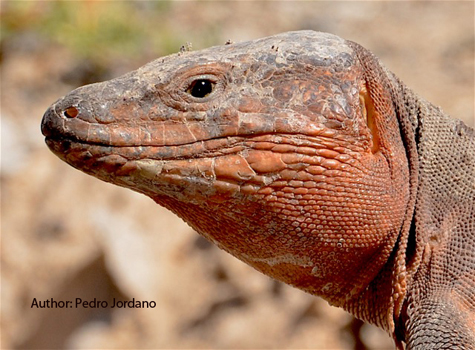Defaunation of large-bodied frugivores could be causing severe losses of crucial ecosystem functions such as seed dispersal. The immediate ecological consequences may include alteration or even collapse of seed-mediated gene flow affecting plant population connectivity, with impacts on the regional scale distribution of genetic variation. Yet these far-reaching consequences of defaunation remain understudied. This study tested whether human-induced defaunation of the Canarian frugivorous lizards altered within-island population connectivity and the amount and large-scale distribution of genetic variation of Neochamaelea pulverulenta, which relies exclusively on these lizards for seed dispersal. Individual plant genotypes from 80 populations were extensively sampled spanning the full geographic range of the plant to examine their genetic diversity, population-genetic network topologies, and the patterns of isolation both by distance (IBD) and resistance (IBR) across three ecological scenarios. Plant genetic diversity appeared unaffected by defaunation-mediated downsizing of frugivorous lizards. However, it was found reduced overall plant population connectivity together with an increased isolation by distance within the most defaunated islands when compared with the scenario preserving the functionality of lizard-mediated seed dispersal. The results, with a significant effect of lizard downsizing, were robust when controlling for biotic/abiotic differences among the three islands by means of isolation by resistance models. These results provide valuable insights into the far-reaching consequences of the deterioration of mutualisms on plant population dynamics over very large spatial scales. Conservation of large-bodied frugivores is thus essential because their irreplaceable mutualistic dispersal services maintain an extensive movement of seeds across the landscape, crucial for maintaining the genetic cohesiveness of metapopulations and the adaptive potential of plant species across their entire geographic range. informacion[at]ebd.csic.es: Pérez-Méndez et al (2017) Persisting in defaunated landscapes: reduced plant population connectivity after seed dispersal collapse. J Ecol doi:10.1111/1365-2745.12848
http://onlinelibrary.wiley.com/doi/10.1111/1365-2745.12848/full









 Las altas temperaturas están provocando que las lagunas y las marismas de Doñana pierdan agua rápidamente
Las altas temperaturas están provocando que las lagunas y las marismas de Doñana pierdan agua rápidamente



